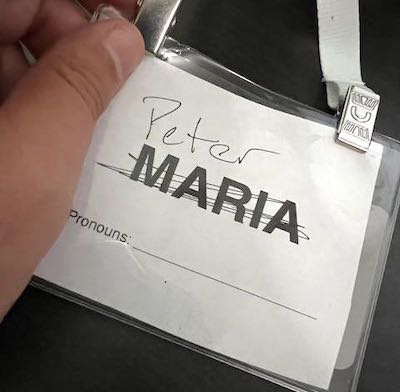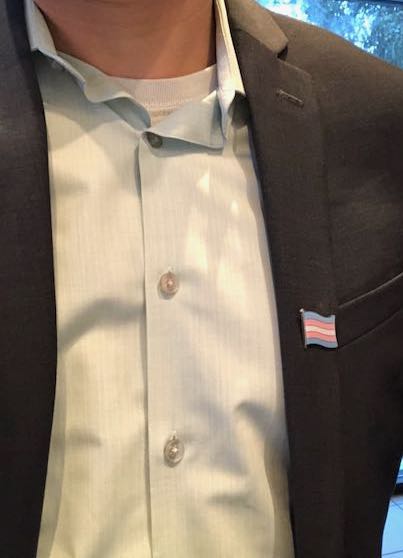Why cisgender people should share their pronouns
It was July, 2016. My oldest kid had recently graduated high school and had just come out to us as gender fluid. I was at the Gender Spectrum family conference, trying to figure out what this all meant, and what it might mean to our family.
My wife and I were splitting a parent registration—she went the first day, and I went the second.
On my day, it wasn’t until lunch break that I realized I had been wearing a name tag that said MARIA. During lunch, I scribbled it out and put in my name instead.

She had left the pronouns line blank, so I didn’t have to fix that.
Until the first session of the afternoon.
A powerful lesson from a totally not weird teenager
The first session after lunch was about microaggressions. The presentation and slide deck were well done, but I don’t remember a word of it.
What I do remember is during the discussion, one teenager raised their hand. I’ll never forget this kid’s name, though I won’t use it here for privacy sake. (It was a cool name, though.)
“All you cis gender people in the room. Look at your name tags.”
I looked at mine and wondered if anyone earlier had thought I was going by the name MARIA, even though I was clearly a man. I was uneasy with the fact that that thought made me uneasy.
The kid continued: “You all left your pronouns line blank, didn’t you?”
Heads all around me nodded.
“That,” the kid said, “is an example of a microaggression.”
Some murmurs of protest and disagreement started to rise from the packed room, but the kid continued.
“That’s because you assume everyone knows your gender identity just by looking at you.”
Well of course they knew my gender by looking at me. I am clearly a man. But—
“Which tells me you think I’m weird. Abnormal.”
The privilege of being part of the in-group 24 x 7 x 365
If we pay close attention to our lives, we can name the precise moments when our perspective changes profoundly and fundamentally. This was one of those moments.
I’d been through a ton of diversity training, so I understood the idea that I was privileged. Straight white male from an educated, Christian background. All the systems in the great U S of A are designed for someone who looks, talks, and acts like me.
But with this one tiny example, this kid did what dozens of hours of diversity training hadn’t: They opened my eyes to what it really meant for someone to be constantly reminded that they are part of the out-group. That they’re weird.
That they’re abnormal.
Aren’t you worried someone will think you’re trans?
At some later point I started adding “he/him” to my email signature, to my Zoom name, to my name badges.
Some people thought it weird that I would announce my pronouns when it was obvious I’m a man. Being thought of as weird felt uncomfortable.
I also bought a trans flag lapel pin and started wearing it whenever I had a lapel. Or on the strap of my laptop bag if I didn’t have a lapel.

It opened up many conversations with people who didn’t know what the flag meant. I got to educate a lot of people through sharing my daughter’s story, and my story as a parent.
Then one day, a good friend took me aside about the lapel pin. “Aren’t you worried someone will think you’re trans?”
As with the conference name badge, this had never actually occurred to me. So I gave it some thought.
“No,” I concluded. “That’s actually the point.”
It may seem counterintuitive for me to identify as male, present as male, openly share my male pronouns, and yet hope that some people think I am transgender when I am not.
But if you have the capacity to believe that a person who looks like me was born with female anatomy, then you have the capacity to believe a trans person is the gender they tell you they are… regardless of how they present.
Because gender is about identity, not anatomy or presentation.
Normalizing the disclosure of your pronouns
It occurs to me now that “normalizing” could itself be a term of microaggression because you can only normalize something that is not normal.
Being trans or nonbinary is not abnormal. It is as normal as any other naturally occurring human trait.

Pew Research Center estimates that about 5% of young adults in the US are trans or nonbinary. That is about the same percentage of humans that have hazel eyes.
Using someone’s pronouns is a way to honor their identity, to affirm that who they are is much more complicated than how they might appear on the surface.
This is true as well for people who have hazel eyes.
What do you think?
I believe my heart is in the right place, but I still have so much to learn about right behavior as an ally. I hope you’ll comment with your thoughts.



2 Comments
Peter · August 17, 2022 at 11:39 pm
ADDENDUM:
A colleague gently reminded me that pronouns are part of someone’s identity, and the term “preferred” is itself a microaggression. I am glad they reminded me!
We are not talking about an itchy sweater. - Gray Bear Coaching LLC · November 25, 2024 at 5:44 pm
[…] I’m not talking about an itchy sweater. I’m talking about people who are different from you. It could be how they worship, the language they speak, their cultural traditions, or many other things. Like their gender identity. […]